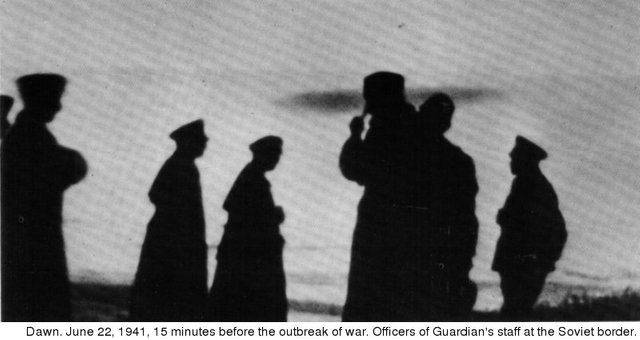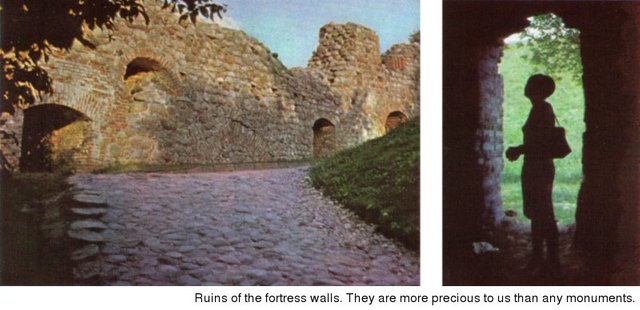Brest Fortress (featuring Vasily Peskov as author)
War broke out on June 22, 1941.
In time the details of great events fade into the past, and memory retains only the most dramatic moments. If you mention Napoleon in Russia everyone will recall the Battle of Borodino, the burning of Moscow and Napoleon's retreat along the Smolensk Road. When speaking of the last war no one will forget the battles of Moscow, Stalingrad, Sevastopol and Kursk, the siege of Leningrad and the fall of Berlin. And the 22nd of June.

An alarm clock was found beneath the rubble of Brest Fortress. It was not destined to ring on the morning of June22nd. The hands on the dial stopped at 4 a.m., crushed by a bomb explosion. A photograph taken fifteen minutes before by a German reporter shows the officers of Guderian's staff standing around expectantly at the border. Dawn was breaking. They still had fifteen minutes to go before Germany attacked the Soviet Union. Guderian was later to recall: "A close observation of the Russian side convinced me that they suspected nothing of our intentions. We could see into the yard of Brest Fortress from our observation posts. A military band played as they changed the guard."
Soviet border guards witnessed the first minutes of the war. Few of them survived. Those who did told their story.
"Up ahead, beyond the border, red and green lights suddenly appeared among the stars in the dawning western sky. The entire horizon was soon dotted with lights. At the same time the roar of a great many motors was heard, also coming from the West. Hundreds of planes, their side lights flashing, were zooming across the border."
Meanwhile, an alarm clock was ticking away peacefully at someone's bedside inside Brest Fortress.
No one could say what happened to the fortress after that. Its fate became known quite by chance, from a dispatch found among captured documents of the German Staff during the war: "The Russians fought very stubbornly at Brest-Litovsk, displaying the infantry's excellent training and exhibiting a fine will to fight." A German general later stated: "That was where we learned what fighting the Russian way was like." And this was not said of Stalingrad, Kursk or Sevastopol. These statements refer to the very first minutes, the very first weeks of the war.
This is a photograph of Brest Fortress or, rather, of its small central part. The quadrangle of two-story barracks of the citadel is nearly two kilometers long, with the ruins of the clubhouse in the former church in the center. The solid outer wall is broken in many places. It was intact until 1941 and had three entrance gates. The fortress is surrounded by the waters of the Western Bug and the Mukhavets, which converge here. The two islands that adjoin the citadel are a continuation of the fortress and have ramparts and bypass canals and are heavily fortified. At one time this was the site of the city of Brest. It was moved to make way for a fortress to be built on this extremely advantageous spot.

We shall soon mark the 130th anniversary of the fortress, an impressive structure for the time. Its fortifications, ramparts, casemates and underground stone chambers were impregnable for as long as smooth-barrelled cannons were in use. Gradually, the fortress became more vulnerable. With the coming of aviation and heavy ground bombs it ceased being a fortress in the old sense of the word. An army garrison was then stationed here.
The fortress is located at the very border. A strip of river lies between it and the woods in which the Germans began building up artillery, infantry and rubber craft on the eve of the attack. It would be wrong to say that the Soviet border guards noticed nothing. Some of the commanders spoke openly of the immediate threat of war. However, the orders from Headquarters were unchanged: "Remain calm. Double your observation posts." Moscow wanted to delay the fateful day for as long as possible and not provoke the Germans to an attack. On June 21st spies dressed in Red Army uniforms were apprehended within the fortress. It later became known that a large number of spies had made their way into the fortress. On the night of June 21st they cut the electric wires and took up advantageous firing positions.
"It was nearly dawn on June 22nd when I got up to nurse my infant daughter. I touched the light switch, but the light did not go on. Soon I went back to bed. Suddenly, there was a clap of thunder, then a blinding light, and the window-frame fell into the room. My husband grabbed his shoulder-belt and gun. He kissed me and said, 'Go down into the cellar! Keep the children close to you. This is war... I never saw him again."
I heard this account of the first minutes of the war from Lydia Krupina who had come to Brest from far-off Magadan "to revisit the past and 1941".
Only a very few people who took part in or witnessed this heroic battle survived. After the war their stories, the human remains, arms and documents found among the ruins all made it possible to recreate a picture of the days and nights of the battle on the banks of the Bug and the Mukhavets. By looking at the photograph we can visualize where the German troops crossed over in their rubber boats on the heels of the artillery barrage. They stormed through the gates of the citadel and occupied the clubhouse, now seen as ruins in the center. It was an excellent vantage point from which to keep the yard under fire. From here the nazis directed their artillery fire by radio. It seemed to them then that things would go according to their plans and the fortress would surrender by noon.
However, after the first few minutes of confusion the fortress suddenly bristled with gunfire and bayonets.
From then on nothing went according to the attackers' plans. They were forced to give up their plan of a frontal attack and begin a siege. The front line had by then advanced far to the East, while here, at the very border, the Germans' heavy-caliber guns kept up their fire. Planes dropped two-ton bombs on the fortress. In the intervals between bombings an insinuating voice came over a loudspeaker, urging the Red Army men to surrender. However, the moment all was still and the German sub-machine gunners rose up, the defenders would open fire again. The forces were unequal. The beleaguered men had only their rifles and machine-guns to ward off the planes, tanks and heavy guns. In fact, there were not even enough rifles.
They did not know how the war was progressing, for they were completely surrounded. For the first two days they waited for help to arrive. The radio operators kept sending out their signals until their batteries went dead. It then became clear to them that they would all have to fight to the death within these walls. Several attempts were made to break through, but the men were forced back, leaving their dead behind. Thus it was the first day, and the second, and the third. A German newsreel shows heavy smoke, crumbling bricks, a frantic white horse rearing through the smoke and the shadows of the nazi sub-machine gunners. The Germans sustained heavy losses here. This unexpected "delay", contrasting with the overall advance, irritated them. With each passing day more and more bombs and shells rained down upon the fortress.
Fewer and fewer defenders remained. Their wives and children were here beside them. The wounded died here and could not be buried. Their ammunition was running out. There was no food left, and no water. The river was only ten meters away, but it was inaccessible. Those who risked venturing forth for water at night were all killed. The men tried digging wells in the casemates, they dipped bedsheets attached to long ropes into the river and after they had pulled them back wrung out the muddy liquid into pails. The smoke, dust and stench of rotting bodies were suffocating. And yet, as soon as the nazi sub-machine gunners rose up, the doomed fortress would open fire.
Minsk had fallen. On July 16th the Germans entered the burning city of Smolensk, but still the defenders of the fortress fought on.
The tremendously superior German forces split up the defenders but could not defeat them. The nazis brought their flame-throwers right up to the loopholes and gun-ports. One cannot think without horror cf what it was like in the underground casemates. The bricks actually melted from the flames, hardening into black shapes like icicles. The fortress was bleeding to death, but would not surrender. The sound of rifle shots and hand-grenades exploding could be heard issuing from the fortress until the last week of July. Here and there fire was carried on singly, with the lone soldiers saving their last bullet for themselves. Three years later we read the words written on the walls: "I'm dying but will not surrender! Farewell, my country. July 20, 1941."
This was just the beginning of the war.
No monument can stir the heart as do these shell-pocked, scorched and battered red brick walls.They are completely gone in spots, in others they have been turned into rubble. Visitors will be shown the place where the regimental banner was buried, and where the Germans executed Commissar Fomin. They will be shown the huge, horseshoe-shaped valiant East Fort that was then under the command of Major Pyotr Gavrilov, a man of exceptional will and courage and now a Hero of the Soviet Union. The awe-inspiring ruins of the former clubhouse stand in the center of the fortress yard. Small birches and weeds have sprung up among the stones and bricks. A frightening chill wafts up from the echoing cellars. Sometimes, after heavy rains, rifle shells that are green from age, or white human bones, or a gun will be suddenly revealed to the eye.

Three hundred-odd men of the seven thousand of the garrison that fought to the death survived the siege. All have returned here after the war. Those who witnessed their meetings said that the gray-haired, middle-aged men would embrace, weep openly and sink down on their knees beside the scorched walls.
Half a million people come here each year. Rallies and reunions are held here. Still, we have not fully realized the impact of these ruins. They are closer to our hearts than any marble monument.